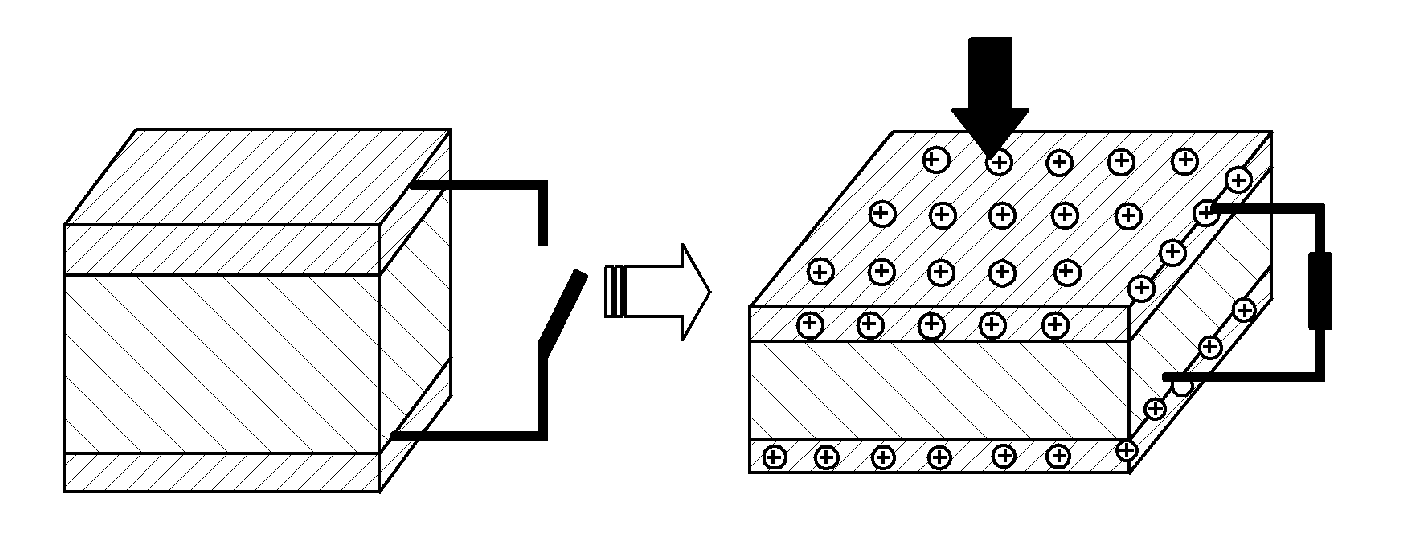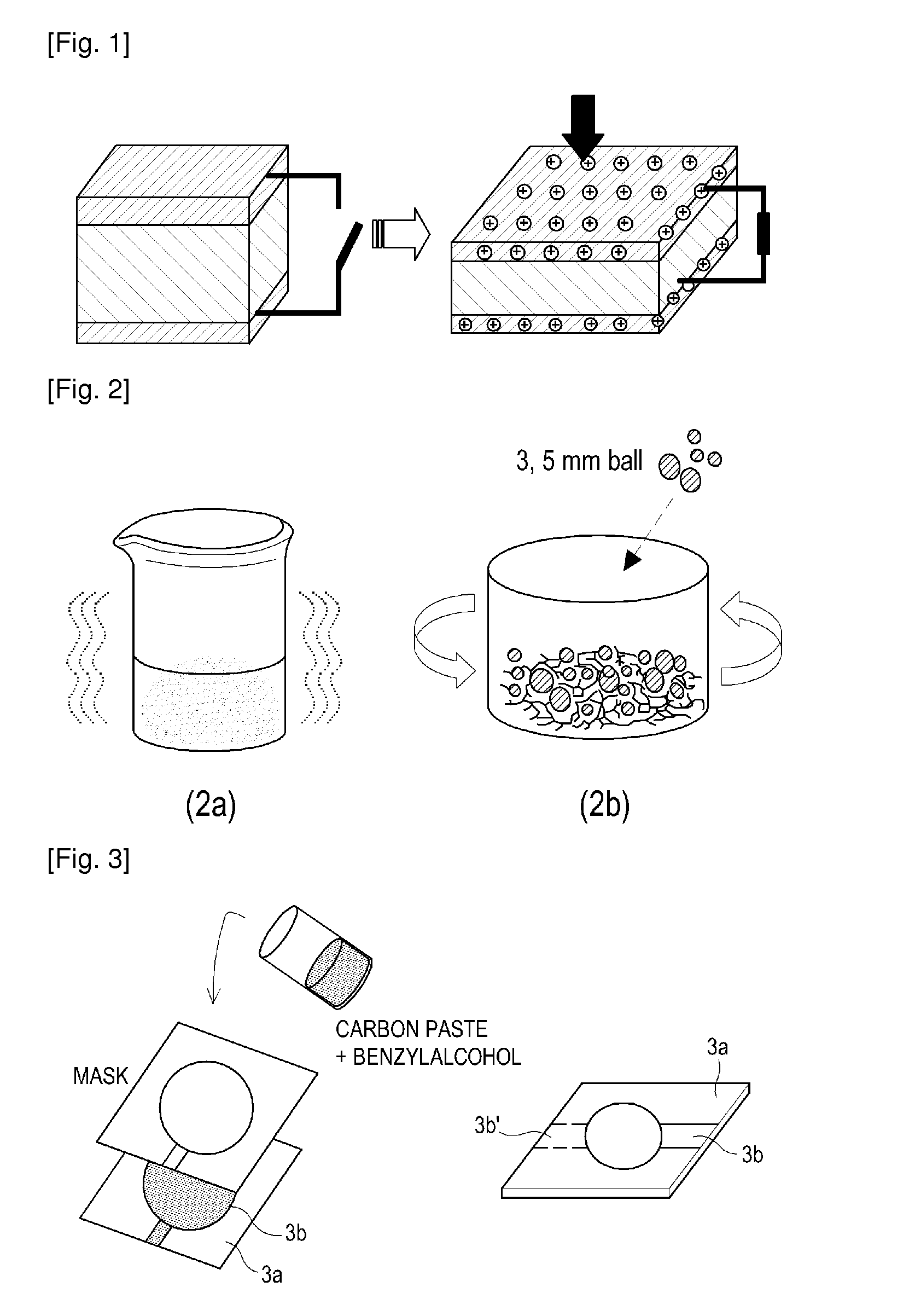Dielectric elastomer composites and actuators using the same
a technology of dielectric elastomer and composite actuator, which is applied in the direction of electrical equipment, electromechanical/electrostrictive/magnetostrictive devices, coatings, etc., can solve the problems of low mechanical strain, high brittleness and high manufacturing cost, and high operating voltage, so as to improve the dispersibility of fillers, improve the electromechanical properties of polymer composite actuators, and improve the effect of filler dispersibility
- Summary
- Abstract
- Description
- Claims
- Application Information
AI Technical Summary
Benefits of technology
Problems solved by technology
Method used
Image
Examples
example 1
[0046]Styrene-ethylbutylene-styrene-g-maleic anhydride (SEBS-g-MA) copolymer (Trade
[0047]Name: FG1901X) having a polar group and provided by Kraton Polymers LLC was used as the resilient dielectric layer (3a). In order to impart plasticization, paraffin-based oil (T-150) purchased from Michang Oil Industry Co. LTD, was added thereto. The copolymer and oil were combined at a content ratio of 20 weight %: 80 weight %. Based on the matrix content, 0.05 weight % of the fillers, single-walled carbon nanotubes (SWCNT, AST-100F) provided by Hanwha Nanotech Co., were subjected to sufficient sonication (2a) with the addition of toluene. Thereafter, ball-milling using a zirconium ball (2b) was performed in a slurry state at 400 rpm for 3 hours. In order to prepare a sample as shown in FIG. 3a, a 7-ton force was applied thereto at 100° C. by compression molding to obtain a resilient dielectric layer of 60×60×0.5 mm3. When forming the upper electrode plane (3b) and the lower electrode plane (3b...
example 2
[0048]In the resilient insulating elastomer matrix, the weight ratio of styrene-ethylenebutylene-styrene comprising maleic anhydride (SEBS-g-MA) to the oil was fixed to 20 weight %: 80 weight %, as described in Example 2. As shown in FIG. 2a, based on the matrix content, 0.05 weight % of the fillers, single-walled carbon nanotubes (SWCNT, AST-100F) provided by Hanwha Nanotech Co., were added thereto and subjected to ultrasonic treatment for a sufficient time with the addition of toluene and 0.1 weight % of the pyrene derivative, N-hexadecylpyrene-1-sulfonamide (Aldrich), which is a dispersion agent. As shown in FIG. 2b, the above mixture was well sonicated with SEBS-g-MA copolymer swelled in paraffin-based oil in a bowl, followed by ball-milling using a zirconium ball in a slurry state for 3 hours with the addition of fillers comprising N-hexadecylpyrene-1-sulfonamide.
[0049]The processes for forming a resilient dielectric layer (3a) and upper / lower electrodes (3b) were carried out a...
example 3
[0050]A resilient insulating elastomer matrix (FIG. 3a) as described in Example 1 was used. 30 weight % of copper phthalocyanine (CuPc) was added thereto as a filler to prepare a dielectric elastomer composite. In order to facilitate the dispersion of the fillers, ultrasonic treatment was performed with the addition of 0.1 weight % of polystyrene having an amine end group which is a dispersing agent for improving the dispersibility of the fillers. SEBS-g-MA, paraffin-based oil, and CuPc comprising polystyrene that has an amine end group were added to the bowl, and toluene was used as a solvent. A zirconium ball was put into the bowl where ball-milling was performed for 3 hours while maintaining the speed at 400 rpm. After the ball-milling was finished, the processes for forming a resilient dielectric layer (3a) and upper / lower electrodes (3b) were carried out as described in Example 1.
PUM
 Login to View More
Login to View More Abstract
Description
Claims
Application Information
 Login to View More
Login to View More - R&D
- Intellectual Property
- Life Sciences
- Materials
- Tech Scout
- Unparalleled Data Quality
- Higher Quality Content
- 60% Fewer Hallucinations
Browse by: Latest US Patents, China's latest patents, Technical Efficacy Thesaurus, Application Domain, Technology Topic, Popular Technical Reports.
© 2025 PatSnap. All rights reserved.Legal|Privacy policy|Modern Slavery Act Transparency Statement|Sitemap|About US| Contact US: help@patsnap.com



